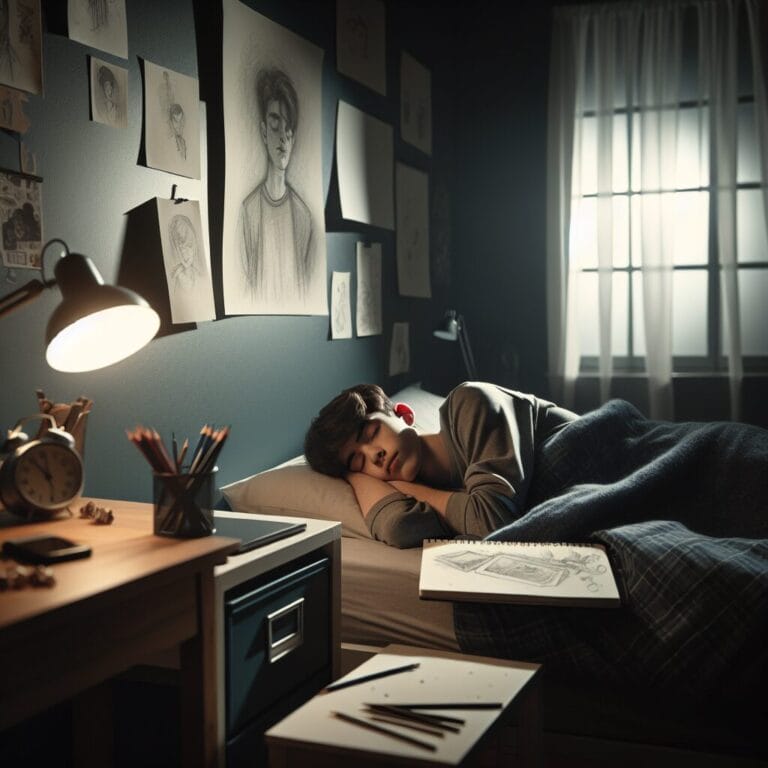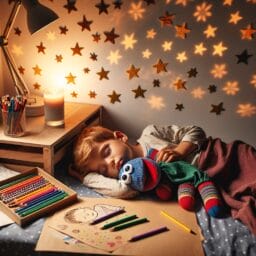
Unlocking Creativity: Sleep Optimization Tips for Teens in the Arts
Table of Contents
- Introduction
- Understanding Sleep and Its Phases
- Challenges Teens Face in Getting Adequate Sleep
- Sleep Optimization Tips for Teens in the Arts
- Additional Resources for Teen Artists
- Conclusion
- Frequently Asked Questions
Introduction
Hey there, young Picassos and Beethovens of the world! Did you know that catching those zzz’s could be your secret superpower? Yep, you heard it right! When teens snooze soundly, they wake up with their creativity meters fully charged, ready to create the next masterpiece. Now, let’s talk about making that sleep magic happen.
Creating a sleep-friendly environment can make all the difference in how quick you fall asleep and stay asleep. Keep your bedroom quiet like a peaceful forest at night; this is where earplugs or a white noise machine can come in handy if there’s too much racket around. Also, dimming the lights an hour before bed signals to your brain that it’s time to wind down—trust me, your sleep patterns will thank you!
Speaking of light, exposing yourself to natural light during the day keeps your internal clock ticking correctly so when bedtime rolls around, your body knows it’s showtime for sleep. And here’s something cool: experts in psychiatry and sleep say that having a regular bedtime routine is like giving a heads-up to your body so it can cruise smoothly into dreamland.
For all you night owls who get hit by inspiration late at night, I’ve got news for ya—tweaking your sleep schedule might bump up those creative bursts even more. Juggling school and art means you’ve gotta find balance; improving sleep is key. Consider chatting with a sleep medicine doc if sleeping problems are throwing off your groove—they’re like detectives figuring out what messes with your slumber.
To build that ideal sleep environment think cozy but not too hot, since cooler temps make sleep easier. And just as important, don’t forget to keep those screens outta sight when it’s close to snoozing time—the blue light from phones is like kryptonite for sleepy teens!
So whether you dance, paint or play an instrument, remember (oops!)… I mean take note: treating yourself to quality shut-eye isn’t just about feeling rested—it unlocks the full potential of that fantastic brain of yours. Now go ahead and dream big—in both ways!
Understanding Sleep and Its Phases
Did you know that our brains cycle through five stages of sleep multiple times a night, and each one plays a star role in keeping our minds sharp and imaginations wild? That’s right, for teen artists aiming to make sleep their ally, understanding these sleep cycles is like having a secret map to buried treasure. The most talked-about is REM (Rapid Eye Movement) sleep, which isn’t just a cool band name! It’s the dream stage where your brain goes on epic adventures, sorting through the day’s experiences and locking in new skills—like nailing that guitar solo or perfecting brushstrokes.
REM is when magic happens; it’s during this deep-sleep concert that your brain connects dots in ways you can’t when you’re awake. This means those zany dreams might be feeding your next big idea! Not getting enough REM time? You might find your well of ideas runs dry quicker than usual. Make catching enough ZZZs a priority, queue up your creativity playlist in dreamland, and watch as your art takes flight!
On the flip side, not landing enough shut-eye can be like trying to paint with a dry brush—nothing good comes out of it. Sleep deprivation scrambles our thinking caps and leaves us more forgetful than an actor forgetting their lines on opening night. For teens who thrive on creating, missing out on quality snooze time can lead to hitting creative walls faster than they can say “Where’s my muse?”
But hey, don’t fret if counting sheep isn’t cutting it! Tackling sleeping problems is easier when you understand what throws off your rhythm. Are late-night screen sessions turning your bedroom into a mini Times Square? Maybe it’s time to transform it into a sleep-conducive environment instead—a cozy cave where tech gadgets are no-nos after dark.
And if all else fails and those sheep keep hopping fences no matter what you do, reach out to those pros in sleep medicine. They’ll help iron out the kinks in your sleep schedule so falling asleep easier becomes second nature—just like sketching or strumming away at melodies.
Bottom line: A symphony of proper rest sets the stage for learning lines, rehearsing steps, or blending colors with ease. Weave these tips into your bedtime routine and let the tapestry of dreams enrich both mind and canvas alike!
| Phase | Description | Benefits | Tips for Artists |
|---|---|---|---|
| REM (Rapid Eye Movement) | The dream stage of sleep where the brain is highly active. | Sorts through daily experiences, locks in new skills, and feeds creativity. | Ensure adequate REM sleep to keep the creative ideas flowing. |
| Non-REM Stage 1 | Transition from wakefulness to sleep. Light sleep. | Brain begins to slow down, muscles relax. | Use this time to unwind and set the stage for restful sleep. |
| Non-REM Stage 2 | Deeper sleep than Stage 1, but still considered light sleep. | Further slowing of the brain waves, heart rate, and breathing. | Minimize disturbances that could wake you during this delicate stage. |
| Non-REM Stage 3 | Deep sleep stage. Difficult to awaken from. | Body repairs and regrows tissues, builds bone and muscle. | Allow enough time for deep sleep to support physical recovery. |
| Non-REM Stage 4 | Very deep sleep. Disorientation if awakened. | Crucial for restorative functions and immune system. | Maintain a consistent sleep schedule to maximize deep sleep. |
| Sleep Deprivation | Lack of sufficient sleep. | Can lead to impaired memory and creativity. | Avoid late-night screen time and create a sleep-conducive environment. |
| Consult sleep medicine professionals if experiencing persistent sleep issues. | |||
Challenges Teens Face in Getting Adequate Sleep
As dawn breaks and the world hits play on a new day, teen artists should already be reaping the rewards of a night well-slept. But here’s an insight that often flies under the radar: adolescents have unique biological sleep patterns that can actually make it tougher for them to fall asleep and wake up early. Think about it – while adults might start yawning when the clock strikes ten, many teens are just hitting their stride. This isn’t just a habit; it’s biology at work!
Understanding these patterns is vital because, for the young creator, sleep isn’t just downtime—it’s when the brain does some heavy lifting behind the scenes. During snooze time, those creative connections get stronger, making sleep important not as an afterthought but as a central part of any artist’s toolkit.
Add into this mix the social and academic pressures teenagers face: homework deadlines, exams, social media buzz—it all stacks up fast! These challenges don’t just fade away at lights out; they can hover like unwanted stagehands in the wings of their minds, contributing to sleeping problems that throw off their sleep schedule.
Now let’s talk tech—screens and gadgets are like magnets for teens’ eyes. While these digital tools can help create art like never before, they also emit blue light which tricks our brains into thinking it’s still daytime—big no-no for trying to make sleep happen! For teen artists glued to tablets or phones perfecting their craft or sharing it with the world, setting boundaries around tech use is critical for cultivating a healthy sleep-conducive environment.
So how do teen Picassos and future Spielbergs dodge these hurdles? It’s about crafting an ideal sleep environment that beckons slumber—their bedroom quiet and darkened without distractions from devices or clutter. And yes, routines matter too! A solid bedtime routine sets up teens’ internal clocks to expect dreamtime soon. Plus integrating practices such as reading under natural light or guided relaxation techniques before bed can encourage eyes to close sooner.
In essence, optimizing teen artists’ zzz’s means creating conditions where fallen-asleep is easy despite busy brains buzzing with ideas—and where REM-rich nights fuel vibrant creations by day. It means recognizing that getting good rest is as essential as any brushstroke or chord struck—a foundational piece of their artistic journey towards mastery.
Sleep Optimization Tips for Teens in the Arts
Hey there, young artists and creators! Let’s shine a spotlight on something super cool: Did you know that sleep can be as much of a muse to your art as a beautiful sunset or an awesome piece of music? That’s right; when teens hit the hay at the same time every night and wake up with the sun, they’re not just getting rest—they’re letting their imaginations soar. So let’s get down to business and talk about how you can make sleep a VIP guest in your life.
First off, let’s paint a picture of what it looks like to have an ideal sleep environment. Imagine your room is your personal studio—each detail matters. Keeping things cool, calm, and collected can actually help you fall asleep easier. This means saying goodnight to all those buzzing gadgets well before bedtime so that your mind isn’t racing faster than a sprinter on opening day!
Now, for all you busy bees juggling school projects with brushstrokes or dance moves, check this out: exercise and nutrition are like secret ingredients in your sleeping potion. Chowing down on too much sugar before bed is like putting energy drink in your chill-out tea—not helpful! Instead, nosh on snacks that are kind to your tummy and won’t keep you up counting candy wrappers instead of sheep.
And talk about lifting spirits without even lifting a paintbrush—getting active during the day makes zzz’s come easier at night. It doesn’t mean running marathons (unless that’s your jam); even stretching or walking works wonders for making that sleep schedule stick.
But hey, sometimes stress wants to crash the bedtime party uninvited. When worries about tomorrow’s audition or gallery showing start doing cartwheels in your head, it’s time for some serious relaxation techniques. Ever tried deep breathing or listening to soft tunes? They’re like gentle lullabies for your brain.
Let’s not forget one last thing—our screens love chatting away into the wee hours if we let them! But here’s some insider info: blue light from phones and tablets messes with our ability to doze off because it tricks our brains into thinking it’s still playtime. Instead of scrolling through feeds at night, why not switch to painting dreams in sketchbooks?
Building these habits might take practice (like perfecting that pirouette or mastering a new melody), but once they become part of your routine, they’ll set you up for nights filled with sweet dreams and days bursting with creativity.
So remember this: behind every curtain call and each stroke of genius is a well-rested teen artist who knows how important sleep is—not just for feeling great but also for keeping those creative fires burning bright!

Additional Resources for Teen Artists
Picture this: you’re a teen artist, and your brain is like an awesome idea factory. To keep the ideas flowing, that brain needs top-notch snooze time—not just any sleep, but the good stuff that gets all your creative gears whirring smoothly. Here’s something cool to think about: there are high-tech sleep tracking gadgets and apps out there that can take a peek into how you snooze. These nifty tools are like secret agents on a mission to uncover what’s up with your sleep schedule so you can make it even better!
But wait, there’s more! When teens sleep matters heaps, because if they don’t catch enough Zs or their sleep patterns go haywire, they might face sleeping problems or even yawn-inducing sleep disorders. If counting sheep isn’t enough to drift off to dreamland, or if nightmares about forgotten lines in the school play keep popping up, it might be time for some pro tips from folks who know loads about psychiatry and sleep medicine. They’re like guides on a trek through the night-time jungle of snooze-ville—super helpful for young artists who need their rest.
And check this out: some places offer workshops that are pretty much like creativity boot camps where getting amazing shut-eye is part of the training. They help teens figure out how to create a sleep-friendly environment so bedtime becomes as chill as hanging out in a cozy hammock. It makes sense when you think about it—learning how to fall asleep easier means more energy for art projects and less dragging feet during rehearsals.
So here’s the scoop for all you aspiring Van Goghs and Lady Gagas: upgrading your slumber skills could totally be your next big project! By tuning into these life hacks and support systems, improving your nighttime routine could turn into painting more colorful dreams by day—and isn’t that what every artist wants?
Conclusion
Hey, teen artists! Let’s chat about something super cool – did you know that your sleep is like a backstage pass to awesome creativity? For those night-time doodles or dance moves to really shine, you’ve got to score solid shut-eye. That means crafting a bedroom quiet as a whisper and dimming down the lights to set the stage for dreamland. And, keep this tip in your paintbox: letting in some sunshine during your day helps keep those sleepy vibes on schedule. Now, if worries are like uninvited critics at your art show, try kicking them out with calming bedtime routines—a little reading or soft music might just do the trick.
But hold up! Here’s something not talked about enough: chowing down right can make sleep zoom into action like a superhero swooping in to save the day! Tossing too much junk food before bed is a no-go; it’s like putting bouncy springs under your pillow when all you want to do is fall asleep easier. Stay cool with snacks that don’t start pillow fights in your tummy. And hey, even though screens are nifty for sharing your art with the world, they’re also sneaky sleep-stealers at night—so give ’em a curfew!
Remember, getting cozy with good Zs isn’t just crafty—it’s smart science backed by sleep medicine gurus who say dreamtime makes brains grow bright ideas just like magic beans sprout beanstalks. So go ahead and give yourself that gift of glow-up rest because when you wake up fresh as new paint on canvas, nothing can stop your artistic groove!


